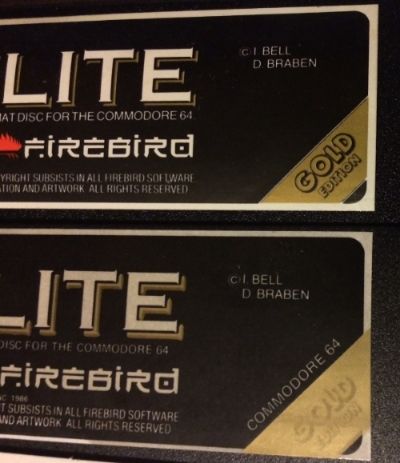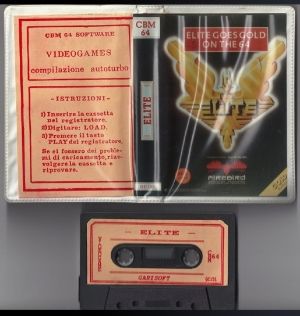RE: Leroy's Helpbook
I found what appears to be a text version of Leroy's Helpbook:
http://www.emuparadise.me/GameBase%20Amiga/Extras/Hints,%20Tips,%20Cheats%20&%20Walkthroughs/E/Elite.txt
Here's the text (I've created the paragraph breaks on my own to assist with reading, I have no idea if that's where they actually were; also the section on dogfights and multiple enemies was missing):
Leroy's Helpbook for ELITE
By David Palmer
Introduction
The majority of video games, whether in the arcade or for home computers, cannot claim to be something that develops meaningful and realistic skills in the player, while at the same time giving entertainment. This is not true for the so-called first-person or simulator games, however. In these games, the player finds himself inside a spaceship, jet, tank, or other vehicle, rather than having an objective or "third-person" view of the action that is usually found in video games.
This first-person perspective is of course the only natural one that a pilot or driver can have, and in mastering these games the player actually develops the skills involved in the real-life activity. Those who train real-life pilots certainly realize this, and today we find that the most sophisticated first-person games are in fact simulators used in Air Force, Astronaut, and other professional programs. And although the average person doesn't have access to this kind of high-priced equipment, a number of worthy simulators have been created for both the arcade and home computers.
This has been my area of interest for several years, and I fell I've had enough experience to know a winner when I see one. It was thus with great pleasure that I had my first playing experience with Elite. In game play, realism, and attention to detail, this may be the best first-person game ever devised. The graphics and game complexity are things not usually regarded as possible for today's low-priced microcomputers.
In this book, I share with the reader those strategies I developed (through over 200 hours of play) that brought me Elite status and a multi- million credit fortune. This is not intended as a substitute for the instruction manual that comes with the game; before reading it, you should study the manual and learn some basics of game play through actual practice. This book is intended as a complement to the manual, something that develops strategy and techniques for specific parts of the game. Although it will be of most help to relative beginners, advanced players should also find items of interest.
Whatever your present level of experience in the game, may your long-awaited attainment of Elite status be as exciting to you as it was to me!
CONTENTS
1. Basics of Flight.................................................... 1
Maneuvering.................................................... 1
Scanner........................................................ 2
Refueling...................................................... 3
Other Screens.................................................. 4
Control Limitations............................................ 4
Saving Games................................................... 5
2. Combat............................................................... 7
Aiming......................................................... 7
Dogfights...................................................... 8
Multiple Enemies............................................... 9
Newcomers......................................................10
Running........................................................10
Insurance......................................................10
Fuel Scoops....................................................11
Defense Against Missiles.......................................11
Types of Enemies...............................................11
Thargolds......................................................12
Combat Rating..................................................13
Hunting........................................................14
3. Rendezvous and Docking...............................................17
Disappearing Stations..........................................18
Approach.......................................................18
Docking........................................................19
Margins of Error...............................................20
Other Ships....................................................21
Docking Computers..............................................21 iv
4. Making a Profit......................................................23
Trading........................................................23
Contraband.....................................................24
Prices.........................................................24
Cop Out?.......................................................26
Return Trip....................................................26
Other Goods....................................................26
Narcotics Officers.............................................27
Diverse Economies..............................................27
Risk Without Yields............................................27
Little Stuff...................................................28
Specific Planets...............................................28
5. Saving Time..........................................................31
Excessive Data Load............................................32
Hyperspace Timers..............................................32
Minor Objects..................................................32
One Last Jump..................................................34
Disappearing Stations Again....................................34
Window Shopping................................................35
6. Incoming Messages....................................................37
Constrictor....................................................37
Thargoids Invasion.............................................37
Further Encounter..............................................38
Attention......................................................39
Trumbles.......................................................39
Constrictor Again..............................................40
Stealth Ship...................................................40
7. Starting From Scratch................................................41
First Run......................................................42
Second Run.....................................................42
Third Run......................................................43
Following Runs.................................................44
A Better Way...................................................45
Hunting........................................................46
End Game.......................................................47
Dangerous Rating?..............................................47 v
1. BASICS OF FLIGHT
Elite gives you the option of either keyboard or joystick control over the maneuvering of you ship. By all means use a joystick, since little is as awkward as trying to control motion with a bunch of buttons. For maximum performance you should also shun the Atari 2600 style joystick, or any like this that are short, clumsy, and have an independently-mounted fire button. You need something like the Wico Command Control stick, with the pistol-grip option: a stick that allows for precise control, is tailored for the human hand, and has a thumb-mounted fire button. The joystick should be securely mounted to a table or desk, with adhesive pads you can buy at hardware stores. Position the computer keyboard just behind the stick and to the side, for rapid manipulation of its function with your other hand. Such simple rules make a tremendous difference in one's success, and it's amazing how often they're overlooked.
Maneuvering
Your ship is fast and precise in its maneuvering, although the mechanics of control are rather unique and take some getting used to. The only way you'll get good at steering and aiming is to practice extensively, but it may clarify matters a little if I explain what's going on in terms of simple geometry.
In most first-person flying games, pulling the stick causes the nose to pull up, while pushing it forward causes the nose to drop. This is also true for real aircraft, where these pitch changes result in climbing and diving (through aerodynamic forces).
A similar pattern is followed by Elite, where a pitch change doesn't just rotate your ship, but puts it on a new heading. Apparently your ship has engines that automatically accelerate it in the direction in which you point it and scrub off speed from the old heading. In most first-person flying games, pushing the stick to the right will steer the craft in that direction, and likewise to the left. A change in yaw is achieved (the nose of the craft moves right or left) as well as a corresponding shift in heading. If the game is an aircraft simulator, this joystick action will also be accompanied by a roll (banking) to the right or left, since such a rolling maneuver is needed in aircraft to achieve maximum turning force and also to make turns more comfortable.
In Elite, pushing the stick to the right or left will only roll the spacecracft: in the same pattern as the rolling of an aircraft, but without any change in yaw or heading. Many situations require changes in yaw or horizontal heading, as where a target lies to the side of your sights. This change in yaw and horizontal heading must be achieved indirectly, by rolling so as to place the target (or desired heading) above or below the sights, and then executing a pitch change to place it in the sights.


